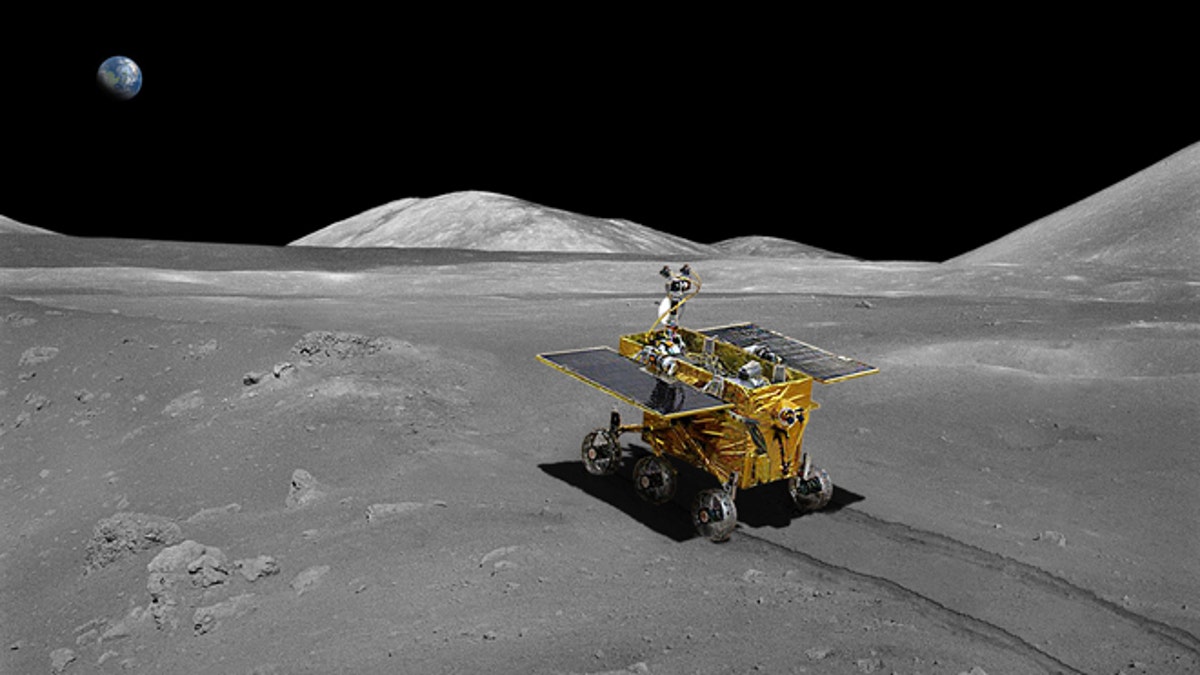Moon walk or Death Star? China’s lunar plans a mystery
{{#rendered}} {{/rendered}}
An artist's conception of China's Chang'e 3 robot on the moon. (ESA)
A Chinese satellite has entered lunar orbit and should drop a robotic probe on the moon as early as Friday -- the first such moon landing in nearly four decades. But China's ultimate plans are unclear, whether simply scientific or the first steps toward a military base on the moon.
The Chang’e 3 satellite was launched from southwest China on Dec. 2 and entered orbit around the moon on Dec. 6. It will deposit a robotic rover on the moon as early as Dec. 14. China’s long range goals are murky, according to Thomas Reiter, director for human spaceflight and operations with the European Space Agency (ESA). Yet militarizing the moon would be a shame, he said.
“I could not imagine that human exploration is getting … pushed by military consideration,” Reiter told FoxNews.com. “It would really be a pity.”
{{#rendered}} {{/rendered}}'It could indicate interest in the next decade in bringing humans to the lunar surface.'
The ESA is helping China to the moon, a landing that will be the first controlled descent since Russia’s Luna-24 landed in 1976. The space agency’s worldwide network of satellites are tracking the science mission while expert teams on the ground are lending technical assistance. But not even the ESA knows exactly what China has planned.
“The strategic long-term goals of China in human exploration … are not very clear yet,” Reiter said. China’s goals could include landing men on the moon, a feat only the United States has managed to do, the last time 41 years ago, he said.
- Alien planet 11 times bigger than Jupiter found in bizarre, massive orbit
- 2013’s top 20 images of planet Earth
- Why is China targeting the moon — and should NASA as well?
- In pictures: ISON, ‘comet of the century’ no more?
- NSA spied on ‘World of Warcraft,’ other online games, leaked documents show
- ‘Nothing is beyond our reach,’ National Reconnaissance Office’s new logo claims
“I believe they are taking a clear path with some first steps, and I could imagine yes, this could be interest in the next decade in bringing humans to the lunar surface.”
{{#rendered}} {{/rendered}}Russia also has shown interest in the moon, Reiter said. Yet the ESA, like NASA, has no concrete plans to do more than help when it comes to lunar exploration.
“NASA is not going to the moon with a human as a primary project probably in my lifetime,” NASA administrator Charles Bolden said at an April panel in Washington. NASA spokesman David Weaver echoed that sentiment, telling FoxNews.com that it is working with international partners to plan missions to the moon and elsewhere.
“We are deeply involved in lunar science, with two satellites currently orbiting the moon,” he said. “The global community is committed to working together on a unified deep-space exploration strategic plan, with robotic and human missions to destinations that include near-Earth asteroids, the moon and Mars.
{{#rendered}} {{/rendered}}Reiter also put the moon on a short list, including low-Earth orbit and Mars. But due to budgetary restrictions, the ESA has no plans of its own to visit the moon.
“For the moment, we do not have a dedicated lunar exploration program,” he told FoxNews.com. At a recent conference in Naples, the space agency proposed a program for a European lunar landing mission to the south pole.
“Due to the overall economic situation of the member states, this could not be approved,” Reiter said. “We are looking into a cooperative mission with the Russian partners.”
{{#rendered}} {{/rendered}}Yet Reiter said the agency remains focused on the moon, despite a decades-long dry spell in lunar landings.
“I believe the moon is still a very important destination,” he said. “If we really intend to take a human mission to Mars … in two decades or maybe a little more, this way leads by the moon.”
